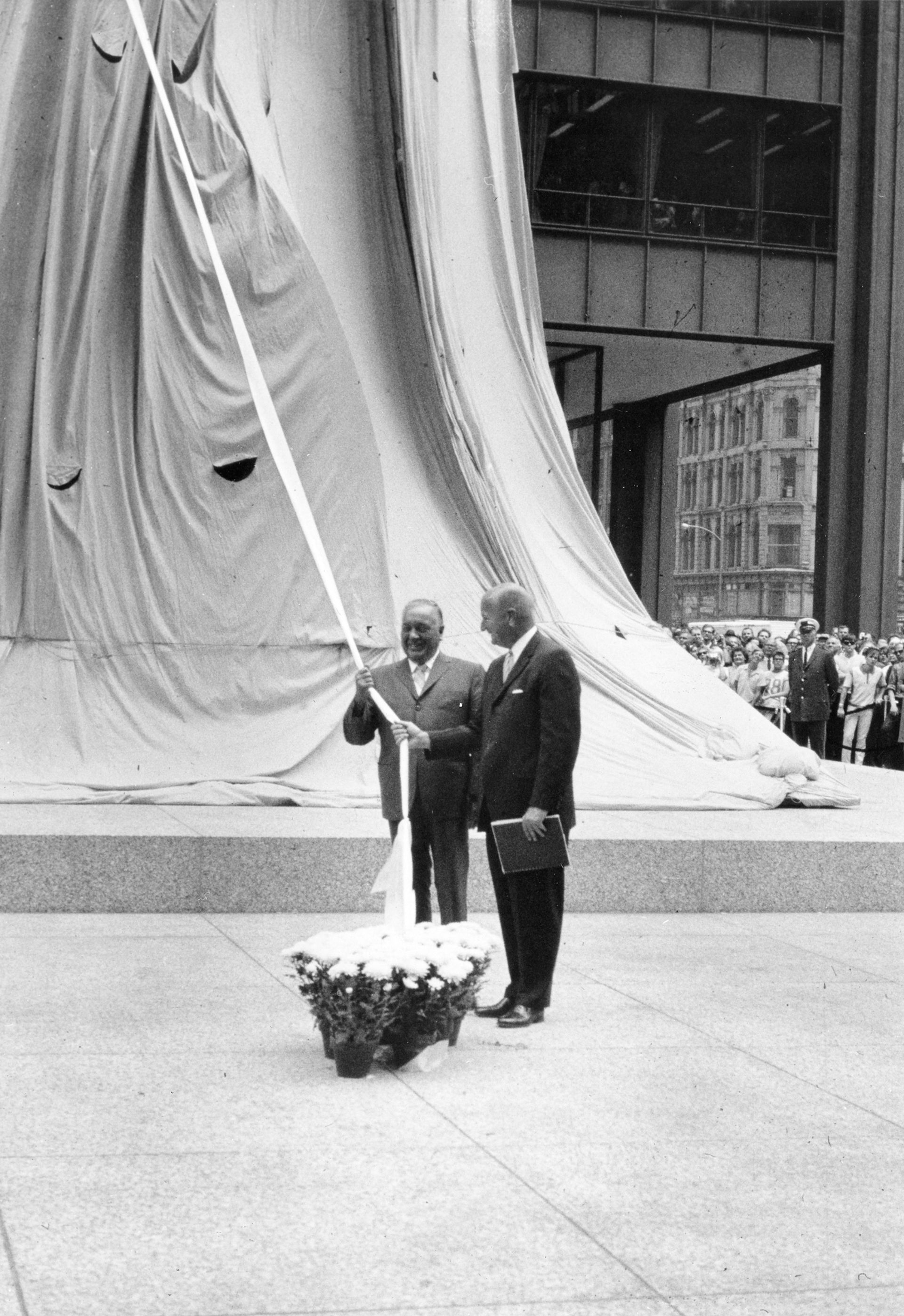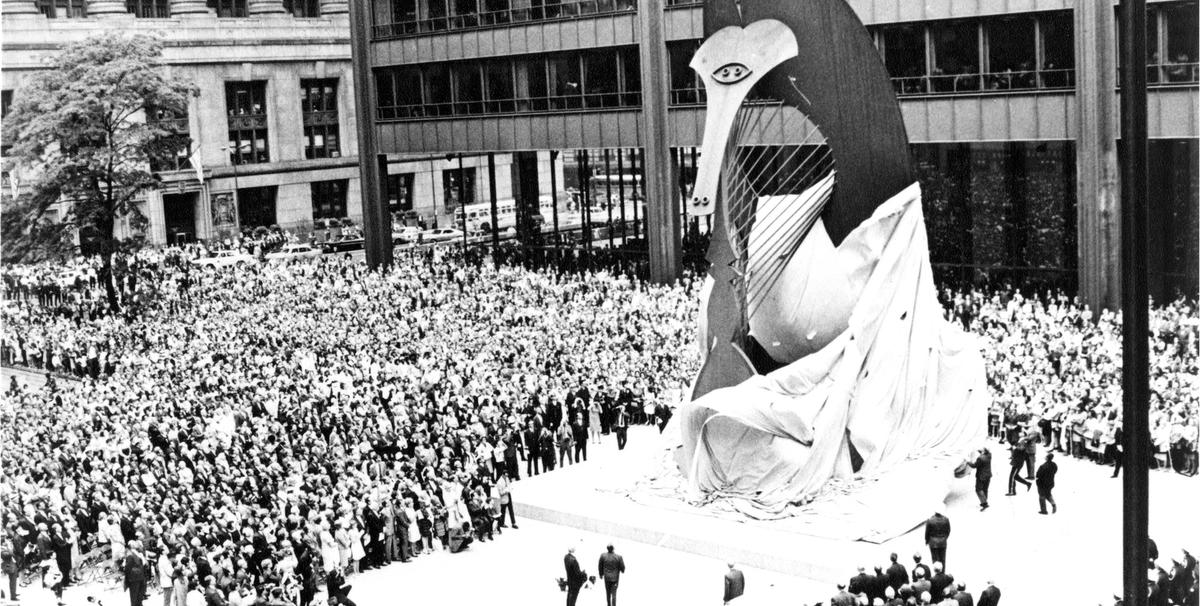Pablo Picasso was 85 when he gave the monumental untitled sculpture now famously known as The Chicago Picasso to the city in 1967. The work precipitated an aesthetic shift in civic and urban planning, broadening the idea of public art beyond the commemorative. In honor of the 50th anniversary of the work’s unveiling, the Department of Cultural Affairs and Special Events is hosting the event Everyone’s Picasso at Daley Plaza on Tuesday, 8 August, at noon.
Paul Durica, a public historian who produces re-enactments and walking tours through his Pocket Guide to Hell series, approached the city with the idea of restaging the dedication ceremony a couple of years ago. Durica was intrigued not only by the scale of the 1967 unveiling—Mayor Richard J. Daley pulled a cord to release the drapery covering the sculpture, the Chicago Symphony Orchestra played, Gwendolyn Brooks read a poem written for the occasion—but with the opportunity to help the public see the work anew. “After half a century, the Chicago Picasso has become part of the built environment,” Durica says. Yet, as is well documented, the Picasso angered and perplexed some politicos and members of the public, either because of its abstraction or because of the artist’s leftist politics.
The sculpture might never have been in danger of being destroyed or being replaced with a statue of Cubs baseball player Ernie Banks (per the wishes of one alderman), but for several years, the word “controversial” preceded any mention of the work in the press. The Chicago Tribune did an informal poll of the public passing by the sculpture which resulted in comparisons to a baboon, a flying nun or “a cow sticking out its tongue”. Then it became a symbol of Chicago. Since there was no copyright on The Chicago Picasso, the image started turning up on merchandise and souvenirs. “As soon as you see it turning up on buttons and coffee mugs, it stops being controversial,” said Durica. It appeared as a background extra in films like The Blues Brothers and Ferris Bueller’s Day Off.
Children began using The Picasso as a slide almost immediately, making it a de facto interactive sculpture—a feature that factors in the instant success of two later public art works in Chicago: Anish Kapoor’s Cloud Gate and Jaume Plensa’s Crown Fountain.
To prepare for the anniversary, Durica researched the archive at Skidmore, Owings & Merrill (SOM), one of the architectural firms that designed the plaza and civic centre, which was later renamed after Mayor Daley. The architect William Hartmann first started the conversation with Picasso and guided the project. Durica was able to study Hartmann’s notes and read a collection of letters responding to the idea for the commission. When Hartmann visited Picasso in the French Riviera in 1963, he brought a care package designed to give the artist a flavour for Chicago that included a Native American warbonnet, a White Sox baseball jersey, Bears football helmet, and photographs of Ernest Hemingway and Carl Sandburg. It was noted that Picasso responded to the image of Hemingway the most, as the two had become friends during their time Paris in the 1920s.

The 50-foot-high Picasso was fabricated at the American Bridge Division of US Steel in Gary, Indiana out of Cor-Ten steel. A structural engineer at SOM scaled up the 42-inch artist-made maquette (now in the collection of the Art Institute). It was assembled on site, hidden by scaffolding and tarps, by a construction crew that welded and smoothed the 162-tonne sculpture. Picasso was sent images of the process periodically, and approved of minor structural revisions made to account for high winds.
Mark Kelly, Chicago’s current cultural commissioner, was 16 and living on the far southside of city when the Picasso was installed. It was the subject of every news outlet and it dominated family conversation. “The tone, and I remember it so vividly, was that we had been had, this alien beast or whatever it is with no name arrived and some poseur artist has played a joke on the city,” he said. But the Picasso captured his imagination. “I would like to believe that I became a little more open and curious to my urban surroundings and to what was considered art.”
But despite the controversy, even at the time of its unveiling the sculpture earned a grudging respect. “It was nothing but a big, homely metal thing. That is all there is to it,” wrote the columnist Mike Royko in the Chicago Daily News. “Some soaring lines, yes. Interesting design, I'm sure. But the fact is, it has a long stupid face and looks like some giant insect that is about to eat a smaller, weaker insect. It has eyes that are pitiless, cold, mean. But why not? Everybody said it had the spirit of Chicago. And from thousands of miles away, accidentally or on purpose, Picasso captured it.”


